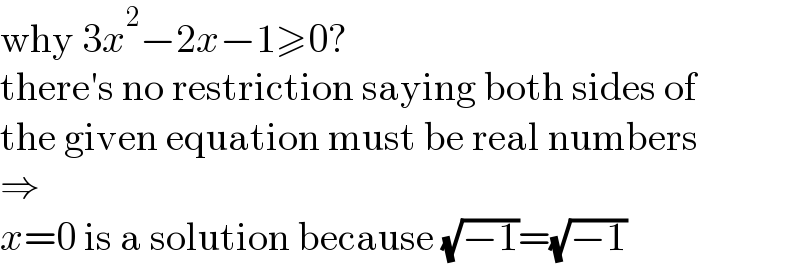
Question Number 179095 by SAMIRA last updated on 24/Oct/22

Commented by HeferH last updated on 24/Oct/22

$${x}_{\mathrm{1}} =\mathrm{1};\:{x}_{\mathrm{2}} =\mathrm{0}\: \\ $$$$\: \\ $$
Answered by aleks041103 last updated on 24/Oct/22
![3x^2 −2x−1≥0 (x−1)(3x+1)≥0⇒x∈(−∞,−(1/3)]∪[1,∞) 2x^2 −x−1≥0 (x−1)(2x+1)≥0⇒x∈(−∞,−(1/2)]∪[1,∞) both must be satisfied ⇒x∈(−∞,−(1/2)]∪[1,∞) then 3x^2 −2x−1=2x^2 −x−1 x^2 −x=0⇒x=0,1 ⇒only ans. x=1](Q179098.png)
$$\mathrm{3}{x}^{\mathrm{2}} −\mathrm{2}{x}−\mathrm{1}\geqslant\mathrm{0} \\ $$$$\left({x}−\mathrm{1}\right)\left(\mathrm{3}{x}+\mathrm{1}\right)\geqslant\mathrm{0}\Rightarrow{x}\in\left(−\infty,−\frac{\mathrm{1}}{\mathrm{3}}\right]\cup\left[\mathrm{1},\infty\right) \\ $$$$\mathrm{2}{x}^{\mathrm{2}} −{x}−\mathrm{1}\geqslant\mathrm{0} \\ $$$$\left({x}−\mathrm{1}\right)\left(\mathrm{2}{x}+\mathrm{1}\right)\geqslant\mathrm{0}\Rightarrow{x}\in\left(−\infty,−\frac{\mathrm{1}}{\mathrm{2}}\right]\cup\left[\mathrm{1},\infty\right) \\ $$$${both}\:{must}\:{be}\:{satisfied} \\ $$$$\Rightarrow{x}\in\left(−\infty,−\frac{\mathrm{1}}{\mathrm{2}}\right]\cup\left[\mathrm{1},\infty\right) \\ $$$${then} \\ $$$$\mathrm{3}{x}^{\mathrm{2}} −\mathrm{2}{x}−\mathrm{1}=\mathrm{2}{x}^{\mathrm{2}} −{x}−\mathrm{1} \\ $$$${x}^{\mathrm{2}} −{x}=\mathrm{0}\Rightarrow{x}=\mathrm{0},\mathrm{1} \\ $$$$\Rightarrow{only}\:{ans}.\:{x}=\mathrm{1} \\ $$
Commented by Frix last updated on 24/Oct/22

$$\mathrm{why}\:\mathrm{3}{x}^{\mathrm{2}} −\mathrm{2}{x}−\mathrm{1}\geqslant\mathrm{0}? \\ $$$$\mathrm{there}'\mathrm{s}\:\mathrm{no}\:\mathrm{restriction}\:\mathrm{saying}\:\mathrm{both}\:\mathrm{sides}\:\mathrm{of} \\ $$$$\mathrm{the}\:\mathrm{given}\:\mathrm{equation}\:\mathrm{must}\:\mathrm{be}\:\mathrm{real}\:\mathrm{numbers} \\ $$$$\Rightarrow \\ $$$${x}=\mathrm{0}\:\mathrm{is}\:\mathrm{a}\:\mathrm{solution}\:\mathrm{because}\:\sqrt{−\mathrm{1}}=\sqrt{−\mathrm{1}} \\ $$
Commented by Acem last updated on 25/Oct/22

$${Idiomatically}\:{it}'{s}\:{dealing}\:{with}\:{real}\:{numbers}\:{unless} \\ $$$${otherwise}\:{stated} \\ $$$$ \\ $$
Commented by Acem last updated on 25/Oct/22

$${Good}\:{Sir}! \\ $$
Commented by MJS_new last updated on 25/Oct/22

$$\mathrm{for}\:\mathrm{me}\:\mathrm{everything}\:\mathrm{is}\:\mathrm{dealing}\:\mathrm{with}\:\mathrm{complex} \\ $$$$\mathrm{numbers}\:\mathrm{unless}\:\mathrm{otherwise}\:\mathrm{stated}. \\ $$
Answered by Acem last updated on 25/Oct/22
![x= 0 ∉ I Refused , x= 1 ∈ I ; The common domain is I= ]−∞, −(1/2)] ∪ [1, +∞[](Q179109.png)
$$\:{x}=\:\mathrm{0}\:\notin\:{I}\:{Refused}\:\:,\:\boldsymbol{{x}}=\:\mathrm{1}\:\in\:{I}\:; \\ $$$$\left.{T}\left.{he}\:{common}\:{domain}\:{is}\:{I}=\:\right]−\infty,\:−\frac{\mathrm{1}}{\mathrm{2}}\right]\:\cup\:\left[\mathrm{1},\:+\infty\left[\right.\right. \\ $$$$ \\ $$
Commented by MJS_new last updated on 25/Oct/22

$$\mathrm{why}?\:\mathrm{obviously}\:\mathrm{we}\:\mathrm{can}\:\mathrm{solve}\:\mathrm{this}\:\mathrm{in}\:\mathbb{C} \\ $$
Commented by Acem last updated on 25/Oct/22

$${Yes}\:{you}\:{can},\:{but}\:{on}\:{the}\:{other}\:{hand},\:{and}\:{in}\: \\ $$$$\:{this}\:{case},\:{what}'{s}\:{the}\:{definition}\:{set}\:{of}\:\sqrt{{x}}\:? \\ $$
Commented by MJS_new last updated on 25/Oct/22

$$\mathrm{sorry}\:\mathrm{but}\:\mathrm{it}'\mathrm{s}\:\mathrm{like}\:\mathrm{saying}\:\mathrm{we}\:\mathrm{cannot}\:\mathrm{solve} \\ $$$$\mathrm{2}{x}+\mathrm{5}=\mathrm{2}\:\mathrm{because}\:\mathrm{it}'\mathrm{s}\:\mathrm{generally}\:\mathrm{understood} \\ $$$$\mathrm{that}\:{x}\in\mathbb{N} \\ $$
Commented by Acem last updated on 25/Oct/22

$${The}\:{general}\:{case}\:{for}\:{polynomial}\:{is}\:{x}\in\:\mathbb{R}\:{not}\:\mathbb{N} \\ $$$$\:{unless}\:{otherwise}\:{stated},\:{as}\:{if}\:{x}\in\:\mathbb{N}\:{or}\:{x}\in\:\mathbb{Z}\:..{etc} \\ $$$$ \\ $$$${The}\:{same}\:{thing}\:{for}\:\sqrt{{ax}^{{n}} +....}\:{the}\:{general}\:{case}\:{is} \\ $$$$\:{ax}^{{n}} +...\geqslant\:\mathrm{0} \\ $$
Commented by MJS_new last updated on 25/Oct/22

$$\mathrm{these}\:\mathrm{are}\:{your}\:\mathrm{rules},\:\mathrm{not}\:\mathrm{general}\:\mathrm{rules}.\:\mathrm{it}\:\mathrm{makes} \\ $$$$\mathrm{no}\:\mathrm{sense}\:\mathrm{to}\:\mathrm{keep}\:\mathrm{on}\:\mathrm{discussing} \\ $$
